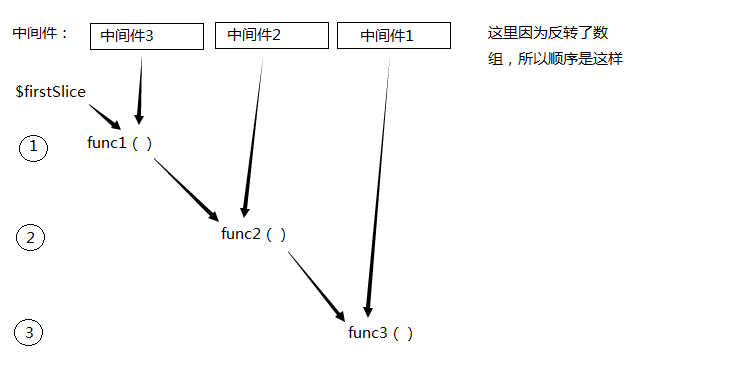The examples in this article describe the implementation principles of Laravel's middleware. Share it with everyone for your reference, the details are as follows:
#1 What is middleware?
For a web application, before a request is actually processed, we may make various judgments on the request before it can be passed to a deeper level. And if we use if else like this, once more and more conditions need to be judged, it will make the code more difficult to maintain, and the coupling between systems will increase, and middleware can solve this problem. We can separate these judgments into middleware, which can easily filter requests.
#2 Middleware in Laravel
In Laravel, the implementation of middleware actually relies on the implementation of the IlluminatePipelinePipeline class. Let's first take a look at the code that triggers the middleware. It's very simple, just transfer the request to a closure after processing and then continue passing it on.
public function handle($request, Closure $next) {
//do something for $request
return $next($request);
}
#3 Internal implementation of middleware
As mentioned above, middleware is implemented by Pipeline, and its call is in IlluminateRoutingRouter
return (new Pipeline($this->container))
->send($request)
->through($middleware)
->then(function ($request) use ($route) {
return $this->prepareResponse(
$request,
$route->run($request)
);
});
As you can see, the middleware execution process calls three methods. Let’s take a look at the codes of these three methods:
send method
public function send($passable){
$this->passable = $passable;
return $this;
}
In fact, the send method doesn’t do anything, it just sets the required The object of pipeline processing in middleware is the HTTP request instance here.
through method
public function through($pipes){
$this->pipes = is_array($pipes) ? $pipes : func_get_args();
return $this;
}
The through method is also very simple, which is to set the middleware processing that needs to be processed.
then method
Here comes the really difficult part. The then method code is very concise, but it is not easy to understand.
public function then(Closure $destination){
//then方法接受一个闭包作为参数,然后经过getInitialSlice包装,而getInitialSlice返回的其实也是一个闭包,如果还不知道什么是闭包先去看PHP文档
$firstSlice = $this->getInitialSlice($destination);
//反转中间件数组,主要是利用了栈的特性,用处接下来再说
$pipes = array_reverse($this->pipes);
//这个call_user_func先不要看,它其实就是执行了一个array_reduce返回的闭包
return call_user_func(
//接下来用array_reduce来用回调函数处理数组,建议先去PHP文档读懂array_reduce的执行原理。其实arrary_reduce什么事情都没干,就是包装闭包然后移交给call_user_func来执行
array_reduce($pipes, $this->getSlice(), $firstSlice), $this->passable
);
}
Then there is no more, so all the middleware is passed. Isn’t it very elegant?
Since the second parameter of aray_reduce requires a function, let’s focus on the source code of the getSlice() method
protected function getSlice(){
return function ($stack, $pipe) { //这里$stack
return function ($passable) use ($stack, $pipe) {
if ($pipe instanceof Closure) {
return call_user_func($pipe, $passable, $stack);
} else {
list($name, $parameters) = $this->parsePipeString($pipe);
return call_user_func_array([$this->container->make($name), $this->method],
array_merge([$passable, $stack], $parameters));
}
};
};
}
See the possibility It will be very dizzy, closure returns closure. To simplify it, getSlice() returns a function A, and function A returns function B. Why return two functions? Because we use $next($request) to pass the object during the transfer process, and $next($request) means that the closure is executed. This closure is function A, and then returns function B. , which can be passed to the next middleware.
Let’s simplify the code again:
//这里的$stack其实就是闭包,第一次遍历的时候会传入$firstSlice这个闭包,以后每次都会传入下面的那个function; 而$pipe就是每一个中间件
array_reduce($pipes, function ($stack, $pipe) {
return function ($passable) use ($stack, $pipe) {
};
}, $firstSlice);
Let’s look at this code again:
//判断是否为闭包,这里就是判断中间件形式是不是闭包,是的话直接执行并且传入$passable[请求实例]和$stack[传递给下一个中间件的闭包],并且返回
if ($pipe instanceof Closure) {
return call_user_func($pipe, $passable, $stack);
//不是闭包的时候就是形如这样Illuminate\Foundation\Http\Middleware\CheckForMaintenanceMode执行
} else {
//解析,把名称返回,这个$parameters看了许久源码还是看不懂,应该是和参数相关,不过不影响我们的分析
list($name, $parameters) = $this->parsePipeString($pipe);
//从容器中解析出中间件实例并且执行handle方法
return call_user_func_array([$this->container->make($name), $this->method],
//$passable就是请求实例,而$stack就是传递的闭包
array_merge([$passable, $stack], $parameters));
}
Look at another picture:

Each iteration passes in the previous closure and the middleware that needs to be executed. Since the array is reversed, Based on the first-in-last-out feature of the stack, middleware 3 is packaged first, and middleware 1 is the outermost layer. Remember, array_reduce does not execute middleware code, but wraps middleware.
You should understand after seeing this, array_reduce will eventually return func3, then call_user_func(func3,$this->passable) is actually
return call_user_func($middleware[0]->handle, $this->passable, func2);
and the handle code in our middleware is :
public function handle($request, Closure $next) {
return $next($request);
}This is equivalent to return func2($request). The $request here is processed by the previous middleware. So the process of Zhengguo middleware is over, and it will be a bit confusing to understand. Just remember that the outermost call_user_func executes the middleware code in the end. I hope this article will be helpful to everyone's PHP program design based on the Laravel framework. helped.
For more detailed explanations of Laravel middleware implementation principles and related articles, please pay attention to the PHP Chinese website!




